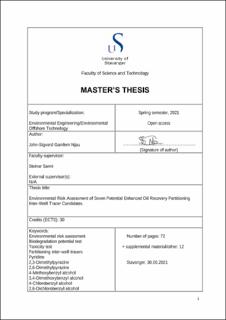| dc.description.abstract | An environmental risk assessment was conducted to characterise and compare the risk of seven shortlisted partitioning inter-well tracer candidates. The candidates were: Pyridine, 2-3-Dimethylpyrazine, 2,6-Dimethylpyrazine, 4-Methoxybenzyl alcohol, 3,4-Dimethoxybenzyl alcohol, 4-Chlorobenzyl alcohol, and 2,6-Dichlorobenzyl alcohol. A literature review for each candidate was done along with a determination of the assessments required for the environmental risk assessment. Once determined, the assessments were conducted to find three properties of each partitioning inter-well tracer candidate. These properties were: the bioaccumulation potential, the biodegradation potential over 28 days, and the toxicity characteristics of the candidates on algae (Skeletonema costatum) and on fish cells (Rainbow Trout gill cells).
The bioaccumulation potential was calculated based on results from work done before this thesis in shortlisting the candidates. Based on these calculations, none of the candidates were found to be effectively bioaccumulating in organisms to a large extent. The biodegradation potential of 2,3-Dimethylpyrazine, 4-Chlorobenzyl alcohol, and 2,6-Dichlorobenzyl alcohol were found to be near the threshold that characterises a compound as persistent while 4-Methoxybenzyl alcohol and Pyridine were the only candidates readily biodegradable. The toxicity characteristics of all the compounds were found to be relatively low and of no substantial concern for the partitioning inter-well tracer applications. The two most toxic compounds of the candidates were 4-Chlorobenzyl alcohol and 2,6-Dichlorobenzyl alcohol. The property of most concern for PITT applications of the candidates was found to be the biodegradation potential.
Discharge data for each candidate and its properties were individually added to a real produced water profile and their discharge scenario simulated over a 30-day period using the dynamic risk and effects assessment model. The model determined the average contribution to the environmental impact factor, a method of characterising risk contribution of compounds. All candidates had an environmental impact factor less than commonly used threshold values and therefore the risk for all seven candidates was characterised as “acceptable”. Regarding contribution to risk comparison of the candidates based on the environmental impact factor it was concluded that the compound with the least risk contribution was 2,3-Dimethylpyrazine, followed by 2,6-Dimethylpyrazine, 3,4-Dimethoxybenzyl alcohol, 4-Methoxybenzyl alcohol, Pyridine, 2,6-Dichlorobenzyl alcohol, and the highest, 4-Chlorobenzyl alcohol. However, based on all assessment conducted, 4-Methoxybenzyl alcohol and Pyridine were determined to be the “best” environmental candidates, as they had acceptable results for all aspects assessed. The other candidates may have better tracer properties and be preferred for applications, in these situations the outcomes of this ERA are designed to form the basis for risk-informed decisions. | |
